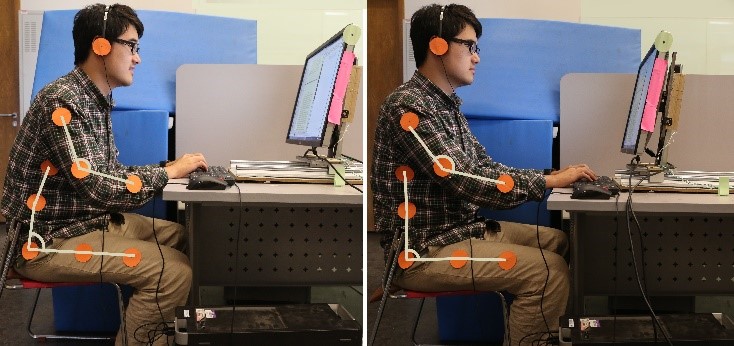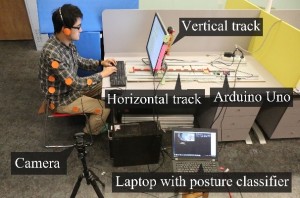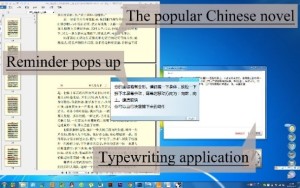Members: Fengyuan Zhu, Ke Fang, Xiaojuan Ma
Contributions: Hardware and Software Design, Experiment Conductor
The related work were arranged into a note and submitted into SIGCHI 2015
Fang ke, Fengyuan Z hu, Xiaojuan Ma, Strategy and Arousal of Cueing in Computer–Human Persuasion and Adherence of Posture Correction Behavior
For more detailed, please contact zhufyaxel@gmail.com
With the need of healthy lifestyles, there has been a growing interest in developing persuasive systems, some research has looked into whether computers can help resolve negative consequences of heavy computer usage, following the Computer-Human Persuasion (CHP) paradigm.
We designed a CHP system – an intelligent computer screen that can sense users’ sitting posture and prompt them to correct it whenever necessary via physical movements, while they are performing a typing task on the computer.
Figure.1 Apparatus, experiment setup and Task interface with popup reminder
Our design of explicit versus implicit cueing strategies corresponds to the two routes of persuasion. We implemented a popup reminder on the screen – one of the simplest, most frequently used interventions to enable the direct, central route to persuasion. However, it may not always provoke reaction in tradeoff with the primary task. Therefore, we created an indirect, peripheral route to persuasion via screen movement based on the Proxemics Theory. We envision that when the screen moves towards the users, they may consciously or unconsciously sit back to keep a distance from the screen. In this case, the system does not clearly notify users of their bad posture; instead, it gets users to react without profound thinking.
The arousal of cueing is another dimension that we are interested in. On one hand, researchers have studied the use of subliminal cueing in CHP, i.e. influence behavior in an unobservable manner without entering consciousness. In our system, we implemented covert cueing as the slow, hard-to-detect screen movement that recedes into the background of experience. On the other hand, some designers made systems that create dramatic experiences to evoke attention and empathy. Such techniques often incite interpretation rather than providing information. In our system, abrupt screen movement serves as a strong stimulation to automate users’ behavior change.
We designed five types of persuasive triggers: 1) reminder followed by abrupt motion (RAM: explicit cueing with high arousal); 2) reminder followed by slow motion (RSM: explicit cueing low arousal); 3) abrupt motion only (AM: implicit cueing with high arousal); 4) slow motion only (SM: implicit cueing with low arousal); and 5) reminder only as the baseline condition (RM). All the judgment and behaviors are conducted by the CHP system, and an intelligent system was designed for aids.
With those different strategy of cueing influence the process of Computer-Human Persuasion. In particular, we study the impact on the attention, comprehension, yielding, retention, as well as perception of heavy computer users with the need of posture correction. Results suggest that 1) a hybrid of explicit and implicit cueing may achieve better attention and comprehension; 2) cueing with low arousal can lead to better behavior yielding and retention as well as more enjoyable experiences; and 3) high-arousal cueing may be more effective and acceptable for less motivated users.
There were several limitations of this study. In the future, we plan to use better sensing techniques to automate the whole process, conduct larger-scale, longer-term field studies, and explore other designs that may better affect users’ behavior and attitudes.


